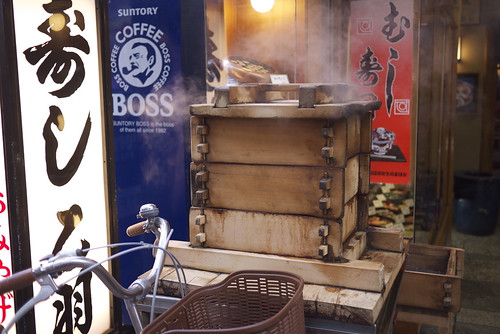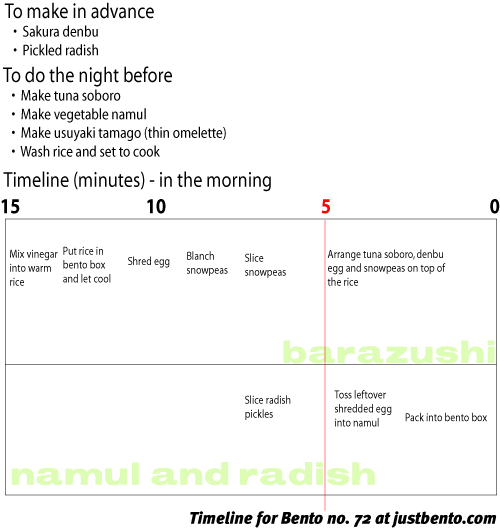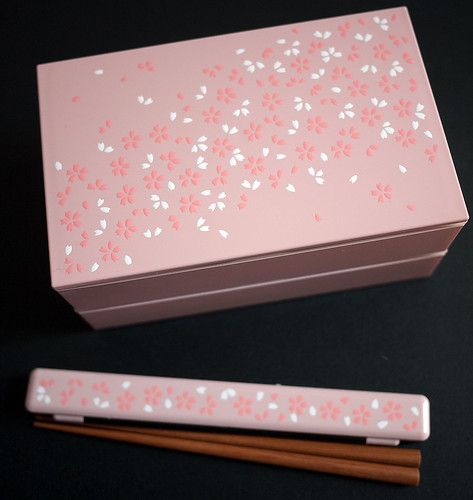Bento no. 72: Sakura Love Kyoto-style Barazushi Bento

Bento contents:
- 1 US cup (240ml) steamed brown rice with 2 tsp. rice vinegar, 220 cal
- 1/2 portion of Tuna Soboro with Ginger, 175 cal
- 2 Tbs. Homemade Sakura Denbu, 50 cal
- Usuyaki Tamago (very thin omelette or egg crêpe) shredded finely (kinshi tamago), from 1 egg, 100 cal
- 1 cup 3 Color Spring Vegetable Namul with Crabstick with "Instant" radish pickles, 90 cal
Total calories (approx): 635 (how calories are calculated)
Time needed: 15 minutes the night before; 15 minutes in the morning
Type: Traditional Japanese with a twist
In the Kanto (Tokyo metropolitan) area where I'm from, barazushi usually means a sort of chirashizushi, with chopped up raw maguro (tuna) or sometimes other fish on top of a bed of sushi rice. (Incidentally, the type of sushi that is popular around the world is based on Edo-mae, or old Tokyo style, sushi.) This is a set lunch I had at a small sushi restaurant in Yokohama, which included a small bowl of barazushi, Tokyo style, with maguro, ika (squid) and other things:
Raw fish is obviously not a good choice for a bento you're going to eat some hours after it's been made. Enter Kyoto-style barazushi. Kyoto does not have direct access to the sea, so traditional Kyoto cuisine does not use raw fish that often. Kyoto style sushi usually just uses cooked or preserved ingredients. For example, a famous type of Kyoto sushi is mushizushi, or steamed sushi. Here's a mushizushi steamer going at full blast.
Here is a simple Kyoto style barazushi that I had in a department store restaurant in Kyoto. It's made up of sushi rice layered with a gingery fish soboro, topped with kinshi tamago or finely shredded Usuyaki Tamago (very thin omelette or egg crêpe), with green peas and sliced kamaboko on top for added color. There were chunks of stewed dried shiitake mushrooms and bamboo shoot in the rice too. Simple yet complicated, and really good!
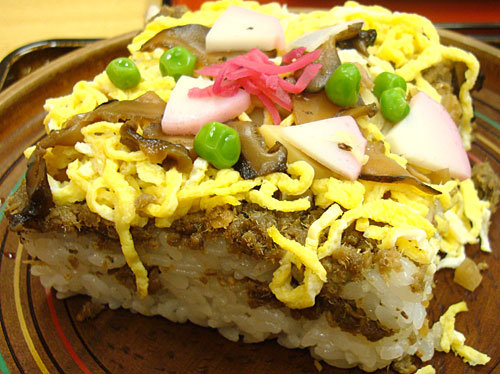
This Kyoto-style barazushi was my inspiration for the main part of the bento. I used brown rice instead of white, with a little rice vinegar mixed in (I didn't add sugar or salt to the rice, since there's enough of both in the other components of this bento). It's layered on top with Tuna Soboro with Ginger - much easier to make than the original fish soboro - and then decorated the top with Homemade Sakura Denbu and kinshi tamago, or shredded Usuyaki Tamago. My greenery is blanched and cut up snowpeas. I started out just sprinkling the sakura denbu on top of the tuna randomly, but it sort of turned into an abstract expression of cherry trees along a river bed or something like that. (One of my favorite entries in the Spring Bento Contest was this simple yet lovely depiction of the cherry trees in Washington DC, which was on my mind when I made this bento.
The other container has some 3 Color Spring Vegetable Namul with Crabstick, topped with a few slices of "Instant" radish pickles made with some really large and colorful radishes with that amazing rose-pink interior.
Timeline
I have not posted a bento timeline in ages - but it's back! Almost all the components are made in advance, except the snowpeas (since they lose color if you blanch them too far in advance) and maybe the egg. Then all you do is assemble everything in the morning. To save time, just throw the toppings on the rice - or be very meticulous and decorative. It's up to you! The namul is just tossed into the other container. Incidentally, I added the leftover shredded egg to the namul. (Click on the timeline image for a bigger view.)
Before and after
I thought it might be fun to show how this bento looks after it's been packed, carried around for some hours, then opened up to eat. (It would be interesting to see how some charaben look after some hours in a backpack...) Here's how the barazushi part looked like before the lid went on...
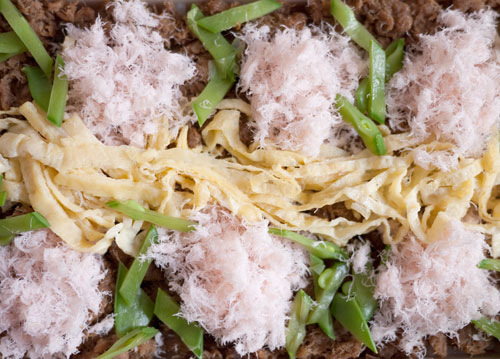
...and this is how it looks, some time after - smooshed! I think it still looks quite okay though, and the flavor certainly wasn't affected.

Here's the barazushi with a bite taken out, so you can see the layers:
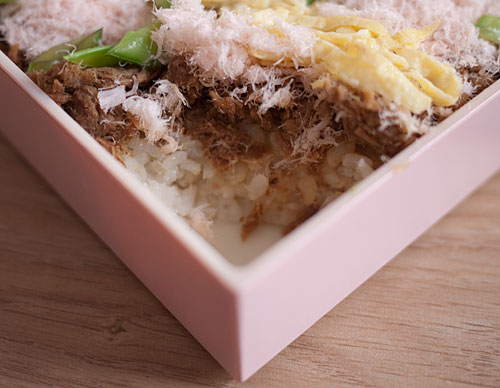
The box I used
Since this is a cherry-blossom bento, I used a cherry-blossom themed bento box that I bought in Japan. This is a fairly large 2-tier box, with 900 ml in total or 450ml per tier. I kept the calorie count down by filling one compartment with the fairly low-calorie vegetable namul. Still, this bento was really very filling!
The box is made in Japan, by a company called Sabu Hiromori, and is part of their "Sakura Saku" series which includes two sizes of bento boxes, single onigiri boxes and drawstring bags (kinchaku) in three colors. I bought this box and the chopsticks box set at Tokyu Hands. It's microwave and dishwasher safe except for the inner plastic lids, as is the case with most bento boxes of this quality and type.I've not seen this series carried by any of the usual international online stores yet, but I'm sure someone will sooner or later. :P
(And by the way, since I get so many questions about what box I used for a particular bento, I will post a picture of the box with every featured bento from now on, with as many details as I can provide.)
If you enjoyed this article, please consider supporting this site by becoming my patron via Patreon.


